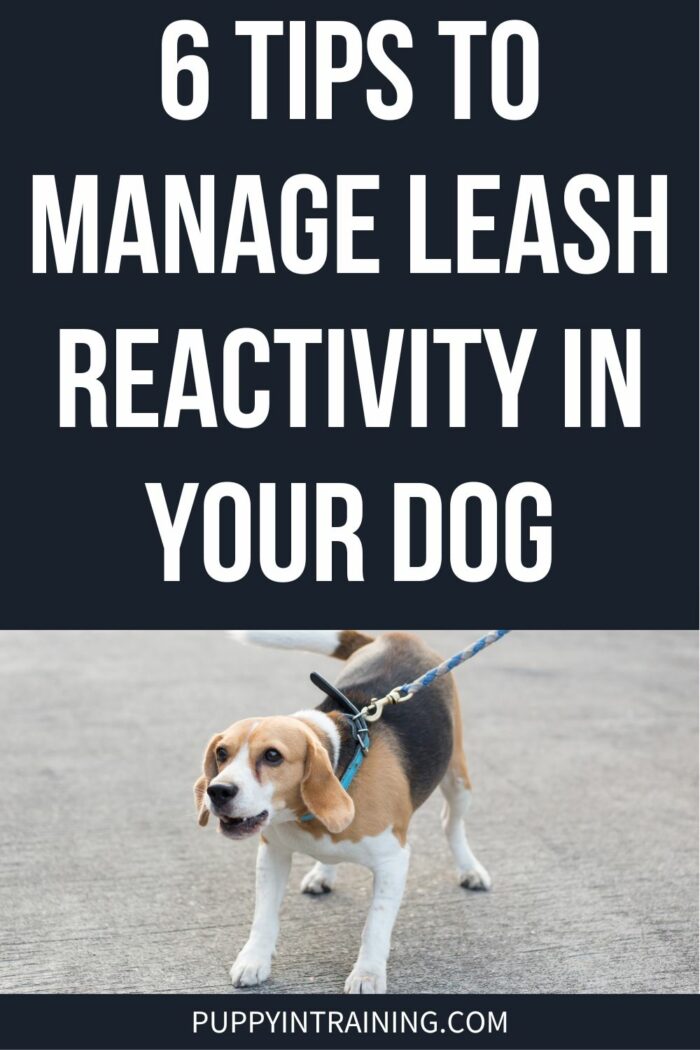This put up might include affiliate hyperlinks. We might earn cash or merchandise from the businesses talked about on this put up.
As a canine father or mother, it may be irritating and embarrassing to have your canine act out in public every time one other canine or an individual is close to.
However on your canine, leash reactivity is commonly greater than an annoyance.
In these moments of reactivity, your canine could also be battling with overwhelming emotions of concern, anxiousness, or stress.
By understanding your canine’s reactivity and the triggers that trigger it, you can begin to deal with the issue.
Managing leash reactivity isn’t simple, however it should can help you forestall a doubtlessly harmful scenario and provides your canine the absolute best life.

What’s Leash Reactivity?
The time period “leash reactivity” refers to any scenario through which a canine turns into overexcited or overstimulated in response to a set off whereas on leash.
This set off might embrace quite a lot of various things, together with (however not restricted to):
- Folks or youngsters
- Different canines
- Livestock
- Wildlife (squirrels, rabbits, birds)
- Automobiles
- Bicycles
- Strollers or wagons
- Particular clothes gadgets (hats, cumbersome winter clothes, and so forth.)
In case your canine is reactive on leash, it might current as being overly excited, freezing up or shutting down, or with behaviors that could be mistaken as aggression, corresponding to growling and lunging.
Different examples of leash reactivity embrace biting on the leash, making an attempt to run away from the set off, or barking.
Is Leash Reactivity Aggression?
The phrases “reactivity” and “aggression” are sometimes used interchangeably. Each behaviors confer with a canine overreacting to a set off however characterize completely different response ranges.
A reactive canine hasn’t but reached the extent of aggression, however this doesn’t imply it received’t get to that state.
In case your canine exhibits indicators of leash reactivity, it should be addressed promptly. Left unmanaged, reactivity can escalate to aggression.
What Causes a Canine to be Leash Reactive?
The largest false impression relating to leash reactivity is that each reactive canine is responding to an abusive previous.
Whereas that is true for some, there are various different attainable causes.
Not all canines which are reactive reply in that method as a result of concern or anxiousness.
In some instances, the reactivity that you simply see outcomes out of your canine being overly excited by the presence of their set off.
After I first adopted our oldest canine Daviana, that was the precise scenario we have been coping with.
Daviana was displaying plenty of leash reactivity towards different canines. She would bark, pull on the leash, and even seize it to attempt to pull free.
This wasn’t aggression. It was pleasure to play. When off-leash, she performed with different canines extremely nicely.
The leash restrained her and prevented her from reaching the canines she wished to play with. This brought on her to really feel overexcited and pissed off.
A number of the commonest causes of leash reactivity in canines embrace the next:
- Lack of socialization/uncertainty in new conditions
- Worry of the unknown
- A earlier traumatic expertise (like a unfavorable expertise with one other canine)
- Barrier frustration
In some canines, reactivity is a response to having been beforehand corrected for responding to a set off.
Image a younger canine that jumps on the finish of the leash or barks in pleasure every time they see one other canine.
If the proprietor makes use of aversive coaching approaches to attempt to cease the leaping (punishing the conduct), the canine might make a connection between the punishment and the set off.
Do Reactive Canines Calm Down with Age?
No, not like some behaviors related to the pet phases of maturity, leash reactivity isn’t a conduct they’ll develop out of.
Ignoring the conduct within the hope that it’ll go away with time will probably solely worsen your canine’s reactivity.
You must contemplate consulting an expert for canine reactivity coaching to deal with the issue.
This consists of coaching instructions that may assist forestall a scenario from creating and counterconditioning to alter how your canine reacts to their set off(s).
6 Tricks to Handle Leash Reactivity
1. Determine Your Canine’s Triggers
Pay cautious consideration to what units your canine off. They may get over-excited seeing different canines like Daviana or are afraid of males with beards.
By figuring out and understanding your canine’s triggers, you may have the knowledge essential to keep away from placing your canine right into a problematic scenario.
2. Advocate for Your Canine in Public
If you end up in a scenario the place somebody is testing or ignoring your canine’s boundaries, don’t wait till it escalates right into a reactive scenario.
As an alternative, be ready to advocate on your canine to stop it from taking place.
Our youngest canine Lucifer remains to be engaged on overcoming fear-based reactivity towards strangers.
To make sure that folks respect his boundaries, we’ve a leash sleeve that states “Do Not Method.”
I’m additionally ready to face up for my canine if wanted.
When somebody approaches us and ignores the leash sleeve, I’ll place myself between Lucifer and the person and make it clear that they don’t seem to be to come back any nearer.
A few years in the past when Colby attended America’s Household Pet Expo there was an organization that created particular leashes, collars, ribbons, and vests to assist signify that your canine is reactive, in coaching, and so forth.
Colby thinks it is a nice thought, nonetheless, common canine homeowners will in all probability not perceive the importance of the completely different colours and due to this fact cut back the effectiveness of coloured leashes, ribbons, and collars.
3. Acknowledge the Indicators of Discomfort
Earlier than reacting, your canine will attempt to talk that they’re uncomfortable.
By recognizing these indicators, you may take steps to get your canine out of the scenario earlier than it escalates to a reactive response.
Widespread indicators of discomfort, anxiousness or heightened arousal in canines embrace:
Don’t wait on your canine to react. A proactive response can be extra comfy for each of you.
4. Study The right way to Navigate Difficult Conditions
There’ll come a time that you’re compelled to get nearer to your canine’s triggers than you want to.
You could be passing a canine on the road or approaching one other hiker on a slim path.
Discover methods to make your canine extra comfy.
This might be main them off the path to take a seat and wait till the set off has handed or transferring in an arc across the set off to keep away from getting any nearer than mandatory.
Reward your canine because the set off passes and the scenario is resolved. It will assist create a constructive affiliation with seeing their set off.
5. Think about Muzzle Coaching
In case your canine’s reactivity features a tendency to chunk or snap, it’s possible you’ll contemplate utilizing a basket muzzle when you find yourself out in public.
This not solely protects others, however it should additionally assist to maintain your canine secure from their very own reactions.
Basket muzzles provide sufficient area on your canine to pant comfortably with none restrictions. Canines also can eat or drink whereas carrying one.
6. Seek the advice of a Skilled
Whereas many canine mother and father will really feel comfy taking over fundamental obedience coaching, working with a reactive canine introduces new challenges and potential penalties, particularly if they’re lashing out in response to their concern and anxiousness.
One of the simplest ways to deal with leash-reactive canine coaching is to take action with the steering of a educated skilled.
Contact a canine behaviorist or a coach with earlier expertise working with reactive canines.
For those who’re not sure the place to begin, attempt looking out the listing on the American Faculty of Veterinary Behaviorists web site.
Ultimate Ideas
In case your canine is displaying indicators of leash reactivity, don’t be discouraged.
The earlier your begin engaged on counterconditioning or desensitizing your canine, the higher your probabilities of success.
Some canines will study to exist in shut proximity to their set off with out responding. However not each canine will make a whole restoration.
Be ready to handle your canine’s surroundings and advocate on your canine transferring ahead.
Do you may have any expertise with a leash-reactive canine?
In that case, we’d love to listen to about your experiences and the way you managed their reactivity within the remark part beneath.
Save To Pinterest

High Picks For Our Puppies
- BEST PUPPY TOY
We Like: Calmeroos Pet Toy w/ Heartbeat and Warmth Packs – Good for brand spanking new puppies. Helps ease anxiousness of their new house. - BEST DOG CHEW
We Like: Mighty Paw Naturals Bully Sticks – All of our puppies like to chunk, nip, and chew. We love utilizing Bully Sticks to assist divert these undesirable behaviors. - BEST DOG TREATS
We Like: Loopy Canine Practice-Me Treats – We use these as our high-value treats for our information canine puppies. - BEST FRESH DOG FOOD
We Like: The Farmer’s Canine – A pair months in the past we began feeding Raven contemporary pet food and he or she loves it! Get 50% off your first order of The Farmer’s Canine.
Try extra of our favorites on our New Pet Guidelines.


